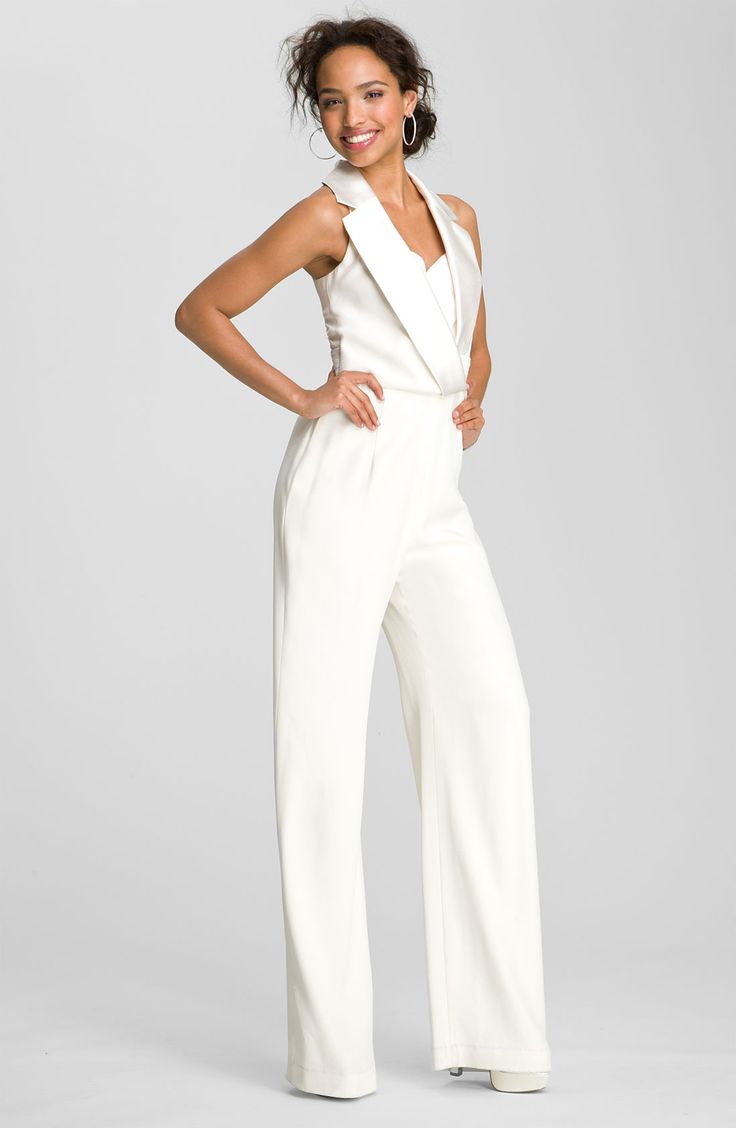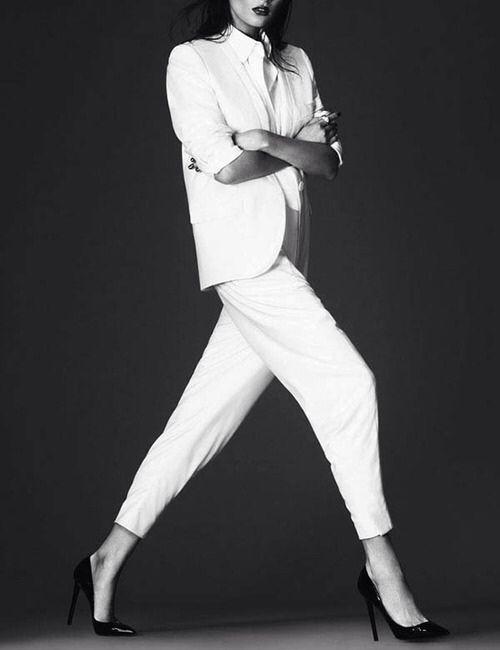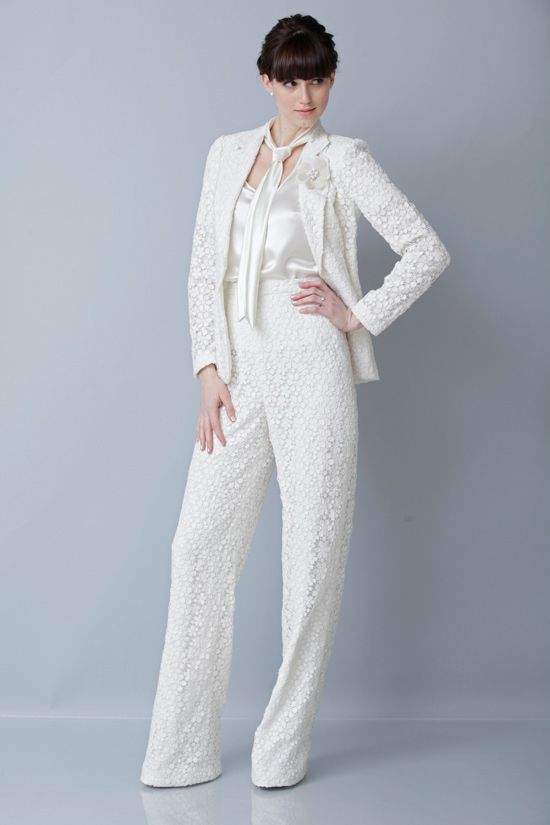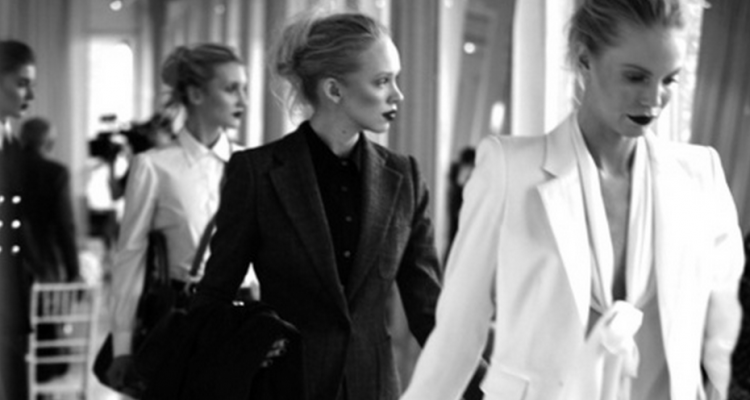Getting married in a suit isn’t exactly an eyebrow-raising idea. Mia Farrow wore one when she got hitched to Ol’ Blue Eyes, and more recently, Camilla Parker-Bowles sported chic coat/dress ensembles at her wedding to Prince Charles. There’s something about a well-tailored suit on the right bride that conveys a certain independence … and élan.
But if you’re picturing yourself more tailored than frilly on your wedding day, you might face some challenges. Who could forget that the full weight of bridal fashion these days falls on plunging necklines and yards of tulle? The good news: for the most important day of your life, you can choose a smart suit and skip the deb dress — and yes, without being mistaken for the MOB.
The not-so-good news: you might have to hunt a little harder than the average bride to find those clean lines you love so much.
From Boardroom to Bridal? Not!
So what sets apart the wedding suit from the everyday? Well, fabric, mainly. For a wedding suit (or coat), the material should be extraordinary. For winter weddings, peau de soie and brocade are luxe, heavier fabric choices that sculpt flatteringly and hold their shape. Linens, and medium-weight silk shantung or dupion have just enough weight to tailor well and look chic for spring-summer weddings.
And though it sounds on the heavy side, a quality wool suit fabric is actually great for any season. Imagine a wool crepe suit in white or ivory, lined in pure silk — this won’t resemble anything you ever wore to the office.
But the jacket’s basic cut will be familiar — either single or double breasted. More radical styles include Neru, Mandarin or Cossack. Shorter jackets, like the Eisenhower and Bolero, look best with skirts that sport higher waistbands, which give you a flatteringly streamlined, columnar look.

Jackets for the Jet Set
Tailored Jacket: The classic. Either single or double-breasted, the tailored jacket ends just below the derriere. It can have a notched or shawl lapel, or none at all. Perfect with a floor-length straight skirt.
Dressmaker Jacket: Shorter than the tailored jacket, this cut stops at the hipline. Can be single or double-breasted. Has the same collar treatments as the tailored jacket. The tailoring usually results in softer lines.
Nehru, Mandarin or Cossack Jacket: All are chic and ethnic-inspired; all have high turtleneck-style collars. Typically tunic-length, each one hints at its exotic origins through the trim or fabric. For instance, Mandarin jackets are usually brocade. The Cossack is any type of wool, and features a row of trim around the collar that trails down the front.
Three-Quarter Length Jacket – Longer than the tailored jacket, this cut’s usually worn over a straight or A-line style skirt. Brides usually put it aside once the ceremony ends.
Eisenhower – Popularized by the General during WWII, this double-breasted jacket crops at the waist. Eisenhower jackets enjoyed a comeback during the mid-70s, and have stayed on ever since as a chic alternative.
Bolero – A shorter, buttonless jacket that crops above the waistline and curves at the front corners.

Seductive Skirts
If it’s the clothes (or woman) that make the man, it’s the skirt that makes the wedding suit. Much like with the traditional gown, formal and semi-formal weddings call for a long, floor-length skirt … which could be straight or A-line.
But don’t be afraid to experiment; even a full skirt complete with a formal train can look great in a suit – as long as the skirt has the proper linings and understructure (read: slip or crinoline) to balance out the jacket you’ve chosen.
And if you don’t feel at home in a skirt at all, then wear pants. Finally, don’t hesitate to wear a veil with a pantsuit if that’s what you want. Be gutsy — set your own trends!

Chasing Camilla
Want even more choices for top-drawer bridal styles? Check out Camilla Parker Bowles’ wedding threads. Coatdresses and coat & dress ensembles like hers are options many women overlook, just because you don’t see them much in the bridal mags these days.
So, what is a coatdress? Just what it sounds like: a lighter-weight coat (street or floor length) that’s single or double-breasted.
On the other hand, the coat & dress ensemble is a coat paired with a dress of matching fabric. In the 60s, these were popular picks for formal occasions. If you like the idea of a fitted coat, you could wear one for your ceremony — long or short — over a coordinating sheath. Afterward, just put the coat aside and relax for the rest of your reception!
Go for ‘Bespoke’ — Or Dazzle With Details
Accessorizing a suit with bridal touches is a great way to pump up that wedding-day glam. For instance, swap out those ho-hum buttons with satin-covered or jeweled ones. Even subtle couture techniques, like hand-bound buttonholes, can make a big impact. If your suit includes a formal floor-length skirt, topping it off with a longer veil looks nuptial without heading straight into ‘sweetheart bride’ territory. Shorter veils like flyaways (shoulder length and above) or net poufs also pair beautifully with suits.
But if you’re not the veil type, consider a complementary hat or headpiece. Hats and suits are a classic match, especially hats with a bit of veiling over the eyes, which replaces the blusher and offers a sophisticated alternative to that symbolic ‘being given away’ business.
The final touch to tie the look together? Gloves, of course. Kid gloves are the most elegant, but net and crocheted ones will lend a strong girly, vintage feel to your ensemble.
Dialing Up That Dream Suit
At first, you’ll probably start your search online. Once you get an idea of your basic desires, call around. You might find a particular designer has the suit you like, but it’s only available in charcoal or pink. Still, the store that carries it might be able to special-order in white.
Looking for a ready-made suit? Department stores could be your best bet. The sales staff know their lines and designers, and can steer you in the right direction. You might find your dream jacket by one designer — your skirt by another. Just make sure the shades of white or ivory involved don’t clash.
Thinking of going custom? Start in a fabric store, browsing the big pattern books, or head online. If you can’t find what you want but have a picture in your head, try a dressmaker or designer with a background in tailoring. Sometimes you can find these in bridal salons, or salons can give you solid referrals.
However you go about starting your search, just know that you’re already well on your way to getting that sleek, chic, 100%-fluff-free silhouette that so clearly says you.
wedding suit, wedding hat, wedding fashion


